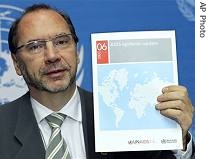2006年VOA标准英语-Global AIDS Epidemic Continues to Grow(在线收听)
By Lisa Schlein
Geneva
21 November 2006
 |
| UNAIDS Executive Director Peter Piot presents the annual AIDS epidemic update report in Geneva, Nov. 21, 2006 |
Latest data shows an estimated 39.5 million people around the world are living with HIV, the virus that causes AIDS. According to the report, this means every eight seconds somebody in the world is infected with HIV, resulting in 11,000 people becoming newly infected every day.
The executive director of UNAIDS, Peter Piot, says most of the new infections, nearly two-thirds, are in Sub-Saharan Africa. But, the biggest increases are in Eastern Europe and Central Asia, where infection rates have risen by more than 50 percent since 2004. He says 2.9 million people died from AIDS-related illnesses this year, the highest number ever.
"So, what is new is that in the report besides this continuing progress of the epidemic is, as I said, that in some countries that were examples for the fight against AIDS that we see an increase in new infections," said Piot. "We see that in Uganda. We see that to a certain extent in Thailand, across Western Europe, the United States and this really has to make us think how to sustain a response to AIDS in the long term because the AIDS epidemic will not be finished in a couple of years from now."
UNAIDS senior epidemiologist, Karen Stanecki, says infections are rising in countries where HIV prevention programs have not been sustained or have not adapted to the changing nature of the epidemics.
"In Uganda where latest national behavioral data shows erratic condom use and rising numbers of men who have sex with more than one sexual partner, there are signs of HIV prevalence rising again in some rural areas," noted Stanecki. "In Thailand, one of our past success stories, a large percentage of new HIV infections are occurring in people considered to be low risk. One third of new infections are among married women."
The report notes some positive trends in young peoples' sexual behaviors. It says data shows increased use of condoms, delay of sexual debut and fewer partners. This has resulted in declines in HIV prevalence among young people between 2000 and 2005 in a number of African countries, including Botswana, Kenya and Zimbabwe.
Nevertheless, the report notes young people between the ages of 15 and 24 account for 40 percent of new HIV infections. It finds the overlap of high risk behavior, such as injecting drug use, unprotected paid sex and men who have sex with men, is a factor of concern in many regions of the world, especially in Asia, Eastern Europe and Latin America.
The report notes the emergence of injecting drug use as a factor of HIV in Kenya, Tanzania, Nigeria and South Africa is a recent development in Sub-Saharan Africa.